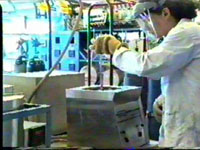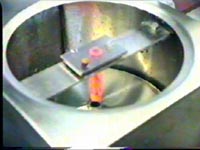What is a Jominy End Quench Test?
Introduction The Jominy end quench test is used to measure the hardenability of a steel. This article considers the basic ideas of hardenability, and the Jominy test. It also discusses how the information obtained from the Jominy test can be used to understand the effects of alloying and microstructure in steels.
Video clip 1: Transferring the sample from furnace to quenching machine

The
specimen is suspended from a wire and held in a furnace to austenitise the microstructure at around 900°C. It is then carefully
and quickly moved to the quenching machine and positioned above a water jet.The water jet is started and sprayed onto the
bottom of the specimen until the specimen is cool.
Video clip 2: Quenching the sample

As
the water jet sprays onto the end of the hot, glowing specimen, a cold dark region spreads up the specimen. The cold region
has transformed from austenite to a mixture of martensite, ferrite and pearlite. The proportions of the phases at any position
depends on the cooling rate, with more martensite formed where the cooling rate is fastest. Ferrite and pearlite are formed
where the cooling rate is slower.
Video clip 3: Jominy end quench test

This alternative longer video clip (contributed by Oxford Brookes University) shows both the transfer of the sample from furnace to Jominy machine, and the jet spraying one end of the sample.
Jominy end quench test
Hardenability
The Jominy end quench test measures the hardenability of steel. This is the ability of the steel to partially or to completely transform from austenite to some fraction of martensite at a given depth below the surface, when cooled under a given condition from high temperature. The quench and temper heat treatment uses this phase transformation to harden steels. After tempering, the martensite microstructure gives the steel a good combination of strength and toughness. Without tempering, martensite is hard, but brittle.
To select steels for a heat treated component, it is important to know their hardenability. Alloying and microstructure both affect the hardenability, allowing the correct steel and quenching rate to be selected. The prior processing of the steel also affects the microstructure, and should also be considered. The hardening of steels can be understood by considering that on cooling from high temperature, the austenite microstructure of the steel can transform to either martensite or a mixture of ferrite and pearlite (figure 1).
The ferrite/pearlite reaction involves diffusion, which takes time. However, the martensite transformation does not involve diffusion and is essentially instantaneous. These two reactions are competitive, and martensite is obtained if the cooling rate is fast enough to avoid the slower formation of ferrite and pearlite. In alloyed steels, the ferrite/pearlite reaction is further slowed down, which allows martensite to be obtained with slower cooling rates. The transformation to another possible phase, bainite, can be understood in a similar way.
The hardenability describes the capacity of the steel to harden in depth under a given set of conditions. For example, a steel of a high hardenability can transform to a high fraction of martensite to depths of several millimetres under relatively slow cooling, such as an oil quench, whereas a steel of low hardenability may only form a high fraction of martensite to a depth of less than a millimetre, even under quite rapid cooling such as a water quench.
Steels with high hardenability are needed for large high strength components, such as large extruder screws for injection moulding of polymers, pistons for rock breakers, mine shaft supports, aircraft undercarriages, and also for small high precision components such as die-casting moulds, drills and presses for stamping coins. The slower cooling rates that can be used for high hardenability steels can reduce thermal stresses and distortion. Steels with low hardenability may be used for smaller components, such as chisels and shears, or for surface hardened components such as gears where there is a desire to maintain a ferrite/pearlite microstructure at the core to improve toughness. The Jominy end quench test is the standard method to measure the hardenability of steels [1].
The Jominy End Quench Test
The test sample is a cylinder with a length of 102 mm (4 inches) and a diameter of 25.4 mm (1 inch). The steel sample is normalised (to eliminate differences in microstructure due to previous forging) and then austenitised. This is usually at a temperature of 800 to 925°C, and transforms the steel microstructure to austenite. The test sample is quickly transferred to the test fixture, which quenches the steel as it sprays a controlled flow of water onto one end of the sample (figure 2). The cooling rate varies along the length of the sample from very rapid at the quenched end where the water strikes the specimen, to slower rates that are equivalent to air cooling at the other end.
The round specimen is then ground flat along its length on opposite sides to a depth of at least 0.38 mm (15 thousandths of an inch) to remove decarburised material. Care should be taken that the grinding does not heat the sample, as this can cause tempering, which can soften the microstructure. The hardness is then measured at intervals from the quenched end. The interval is typically 1.5 mm for alloy steels and 0.75 mm for carbon steels, beginning as close as possible to the quenched end.
The hardness decreases with distance from the quenched end (figure 3). High hardness occurs where high volume fractions of martensite (figure 1) develop. Lower hardness indicates transformation to bainite or ferrite/pearlite microstructures (figure 1). The measurement of hardness is commonly done using a Rockwell or Vickers hardness test [1-3]. Conversion charts are available to relate the different hardness scales [4,5] if necessary, but care should be taken to use the correct charts for steel. The Rockwell and Vickers hardness tests deform the metal differently, and the results are affected by work hardening. The hardenability is described by a hardness curve for the steel (figure 3), or more commonly by reference to the hardness value at a particular distance from the quenched end.
Uses of Hardenability
Data from the Jominy end quench test can be used to determine whether a particlar steel can be sufficiently hardened in different quenching media, for different section diameters. For example, the cooling rate at a distance of 9.8 mm from the quenched end is equivalent to the cooling rate at the centre of an oil-quenched bar with a diameter of 28 mm. Full transformation to martensite in the Jominy specimen at this position indicates that a 28 mm diameter bar can be through hardened, i.e. hardened through its full thickness.
A high hardenability is required for through hardening of large components. This data can be presented using CCT diagrams (Continuous Cooling Transformation) [6], which are used to select steels to suit the component size and quenching media (Figure 4). Slower cooling rates occur at the core of larger components, compared to the faster cooling rate at the surface. In the example in figure 3, the surface will be transformed to martensite, but the core will have a bainitic structure with some martensite. Slow quenching speeds are often chosen to reduce distortion and residual stress in components. Reference 6 contains further information on the heat treatment and properties of steels.
Effects of Alloying and Microstructure
The Jominy end quench test measures the effects of microstructure, such as grain size, and alloying on the hardenability of steels. . The main alloying elements that affect hardenability are carbon, a group of elements including Cr, Mn, Mo, Si and Ni, and also boron [7]. Reference 7 contains further information about the microstructure and metallurgy of steels.
Carbon
Carbon controls the hardness of the martensite, and increasing the carbon content increases the hardness of steels up to about 0.6wt% Carbon. At higher carbon levels, however, the critical temperature for the formation of martensite is depressed to lower temperatures. The transformation from austenite to martensite may then be incomplete when the steel is quenched to room temperature, which leads to retained austenite. This composite microstructure of martensite and austenite gives a lower hardness to the steel, although the hardness of the martensite phase itself is still high (figure 5).
Carbon also increases the hardenability of steels by retarding the formation of pearlite and ferrite. Slowing down this reaction encourages the formation of martensite at slower cooling rates. However, the effect is too small to be commonly used for control of hardenability. Furthermore, high carbon steels are prone to distortion and cracking during heat treatment, and can be difficult to machine in the annealed condition before heat treatment. It is more common to control hardenability with other elements, and to use carbon levels of less than 0.4wt%.
Chromium, Molybdenum, Manganese, Silicon, Nickel, Vanadium
The elements Cr, Mo, Mn, Si, Ni and V all retard the phase transformation from austenite to ferrite and pearlite. The most commonly used elements are Cr, Mo and Mn. The retardation is due to the need for redistribution of the alloying elements during the diffusional phase transfromation from austenite to ferrite and pearlite. The solubility of the elements varies between the different phases, and the interface between the new growing phase cannot move without diffusion of the slowly moving elements. There are quite complex interactions between the different elements, which also affect the temperatures of the phase transformation and the resultant microstructure. Alloy steel compositions are therefore sometimes described in terms of a carbon equivalent, which describes the magnitude of the effect of all of the elements on hardenability. Steels of the same carbon equivalent have similar hardenability.
Boron
Boron is a very potent alloying element, typically requiring 0.002 to 0.003wt% to have an equivalent effect as 0.5wt% Mo. The effect of Boron is also independent of the amount of Boron, provided sufficient is added. The effect of Boron is greatest at lower carbon contents and it is typically used with lower carbon steels. Boron has a very strong affinity for oxygen and nitrogen, with which it forms compounds. Boron can therefore only affect the hardenability of steels if it is in solution. This requires the addition of "gettering" elements such as Aluminium and Titanium to react preferentially with the oxygen and nitrogen in the steel.
Grain Size
Increasing the austenite grain size increases the hardenability of steels. The nucleation of ferrite and pearlite occurs at heterogeneous sites such as the austenite grain boundaries. Increasing the austenite grain size therefore decreases the available nucleation sites, which retards the rate of the ferrite/pearlite phase transformation (Figure 6). This method of increasing the hardenability is rarely used since substantial increases in hardenability require large austenite grain size, obtained through high austenitisation temperatures. The resultant microstructure is quite coarse, with reduced toughness and ductility. However, the austenite grain size can be affected by other stages in the processing of steel, and therefore the hardenability of a steel also depends on the previous stages employed in its production.
Summary
The Jominy end quench test is the standard method for measuring the hardenability of steels. This describes the ability of the steel to be hardened in depth by quenching. The hardenability depends on the alloy composition of the steel, and can also be affected by prior processing, such as the austenitisation temperature. Knowledge the hardenability of steels is necessary to select the appropriate combination of alloy and heat treatment for components of different size, to minimise thermal stresses and distortion.
Noncommercial-Share Alike 2.0 Licence UK: England & Wales
https://creativecommons.org/licenses/by-nc-sa/2.0/uk/
thermal conductivity, k (W/m K)
specific heat capacity, c (J/kg K)
density, ρ (kg/m3)
or select a material
Steel
Aluminium
Graphite
bar length (m)
initial bar temperature (K)
water jet temperature (K)
environment temperature (K)
jet/bar heat transf coeff (W/m2 K)
bar/env heat transf coeff (W/m2 K)
set simulation parameters
simulation run time (s)
Run in real time
Run as fast as possible





0 Comments